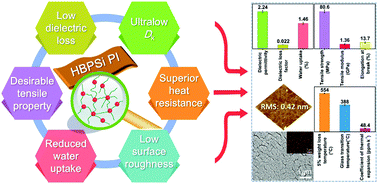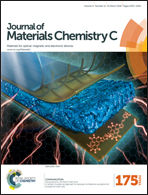Hyperbranched polysiloxane (HBPSi)-based polyimide films with ultralow dielectric permittivity, desirable mechanical and thermal properties
Abstract
Low-dielectric polyimide (PI) is on high demand in the next generation of high-density and high-speed integrated circuits. The introduction of fluorine or pores into PIs has been reported to efficiently obtain low-dielectric properties, but unavoidably deteriorate the mechanical and/or thermal properties. Therefore, it is a great challenge for PI to decrease its Dk and simultaneously maintain its mechanical and thermal properties. Herein, a series of robust PI films were fabricated by copolymerizing amine-functionalized hyperbranched polysiloxane (HBPSi) with pyromellitic dianhydride (PMDA) and 4,4′-oxydianiline (ODA). The outstanding dielectric properties were achieved in a 35 wt% HBPSi PI film, which exhibits a Dk as low as 2.24 (1 MHz), mainly owing to the enhanced free volume and dielectric confinement effect afforded by the bulky HBPSi. Meanwhile, 35 wt% HBPSi PI demonstrates remarkable thermal stability and admirable mechanical properties, with the glass transition temperature of 388 °C, 5% weight loss temperature in argon flow up to 554 °C, a tensile strength of 80.6 MPa, elongation at break of 13.7% and a tensile modulus of 1.36 GPa. It also demonstrates conspicuous film homogeneity and planarity with the surface roughness as low as 0.42 nm and good moisture resistance with water uptake less than 1.5%. The prominent comprehensive properties make HBPSi PI a strong candidate for the future interlayer dielectrics.


 Please wait while we load your content...
Please wait while we load your content...